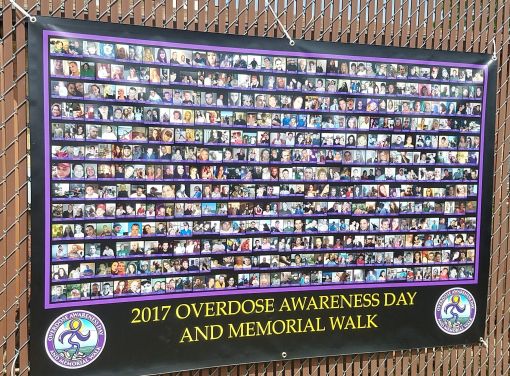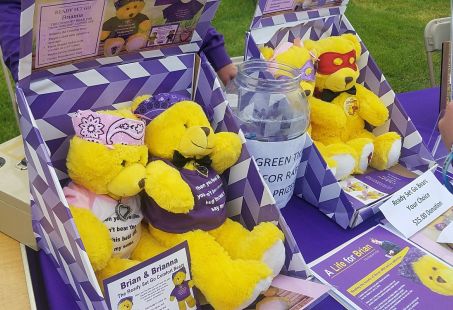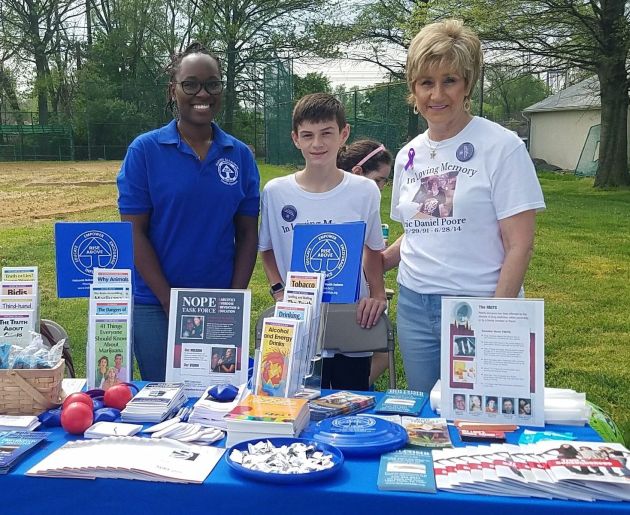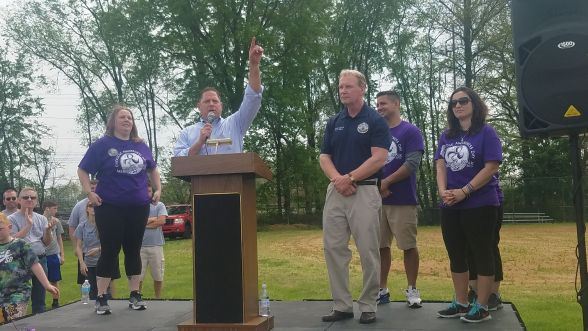In 2014, Christine Cocker-Hastings lost her brother to drug addiction after he overdosed. She then started the annual overdose awareness and memorial walk in his honor. A year later, Crocker-Hastings and Valerie Schina started The Bridge to Recovery Foundation to help people struggling with addiction and give them a way out.
The overdose and memorial walk was held in Eddystone, Pennsylvania. on Sat. April 29.
According to Statista, the state of Pennsylvania had 3,264 overdose deaths in 2015.
At the walk, thousands of people came to support those who are recovering and those who they lost in the battle of addiction. Many wore t-shirts with the name, picture and date of when they lost their beloved family members.
Jackie Casey went in honor of her niece, Lacey Scully. Scully had only been out of recovery for a few weeks before she died of accidental overdose along with her boyfriend in November 2016.
“Lacey was a beautiful girl inside and out,” Casey said. “She had a heart of gold.”
Scully had plans to go to art school in Philadelphia before she passed away.

“She was like another daughter to me,” Casey said.
“Today she is shining down, looking down on all of us and glad that we are here for this walk,” Casey said.
Casey pleads that people “don’t think they can have that one time cause that one time can turn into your not here.”
Casey is glad that her and her family found the walk and says “if it can touch one or two people today then this walk was a huge success.”
Others, like Cocker-Hastings, took the grief of losing their loved one and put it towards helping others.
Carol Cooper began the A Life For Brian Foundation. Cooper was a single mother and lost her only child, Brian, on July 15, 2016 due to an overdose of heroin-fentanyl.
“My mission now is to try and save as many lives as I can through the foundation I started, A Life For Brian,” Cooper said.
Cooper’s foundation makes stuffed bears to help people cope with losing a loved one from drug abuse and help those who are struggling.

Photo By Kaitlyn DAmbrosio
There are two variations of the bears. The first bear, the Ready Set Go Comfort Bear, is for somebody who lost a loved one due to addiction. It has a locket that the owner can put the picture of who they lost in it and it wears a shirt that says ‘When you feel like you can’t bear the pain, hug this bear and say my name.’
The second bear, the Anti-Addiction bear, wears a cape, mask and a button that says ‘I will fight this battle and win.’ It also includes a pamphlet on how to build their self-esteem while in recovery. The Anti-Addiction bears come in male and female versions, Brian and Brianna
“It means get ready to overcome your fears, set your goals high and get ready to be the best you can be,” Cooper said. “The money that I raise will go towards helping people that need my help in any way.”
Cooper uses The Life of Brian Foundation to help other people struggling with addiction.
“I am now connected with the Hansen Foundation,” Cooper said. “I provide sober living for those transitioning from rehab but I am willing to offer scholarships to anybody that needs my help and by saving a life that is how I will heal.”
Marie Datillo is a volunteer for the Narcotics Overdose Prevention and Education (NOPE) Task Force. The NOPE Task Force goes to different schools, middle school, high school and college, and educates them on the dangers of drugs and what they can do to people.
“We go into the schools to educate students on the dangers of prescription

drugs and combining drugs,” Datillo said. “We educate students on the Good Samaritan law, where if they are with someone that overdoses they can call 911 and get help and neither of them, the person who calls or the person who overdoses, will be in any trouble with the law.”
Datillo lost her grandson, Eric Poore, of an accidental overdose on June 28, 2014.
“That’s why I do what I do because I don’t want other young students or children to make the same poor choice that he did,” Datillo said. “He didn’t know that the first time he smoked a joint or drank alcohol that he was turning on that genetic predisposition in his brain that was going to lead his to the path of addiction.”
The NOPE Task Force is run through Holcomb Behavioral Health Systems.
“Just keep spreading the word,” Datillo said. “We need to stop the next generation from making these poor choices. We are losing too many children.”
Social Workers and counselors work tirelessly to help those who struggle with addiction.
Peter Brizick is a recovery coach for Espenshade Counseling. He was inspired to be a recovery coach after going through recovery himself.
“The process of getting myself together and recovering myself lead me to want to do this as a career and help other people get better,” Brizick said.
Espenshade has 35 to 40 clients and Brizick works with about half of them and “to a degree I interact with almost every client we have.”
There are different roles recovery coaches take on when they have a client. Some work with the addicted person while others work with the families. Brizick says that the drug problem today is “horrendous and taking way too many lives.”
“I think the best thing we can do is everyday do our work client by client, person to person and just make a difference on an individual person basis and hope,” Brizick said.
“Drugs and alcohol have always been a problem,” Pat Brown, drug and alcohol interventionist, said. “Our current epidemic has blown up today because of accessibility and cost,”
Brown works with families to help them try and get their loved one who is addicted into treatment and help.
“Ideally, the only solution that is tangible is we must keep talking about it,” Brown said. “The more we talk about it, the more it’s not taboo.”
Brown believes that if drug addiction is talked about more than it eliminates the stigma and people will be less afraid of admitting and getting help for their drug abuse.
Brown also teaches ECG 200: Rethinking Addiction at Cabrini University. He brought his class to the walk so they can witness the realities of addiction face-to-face.
“Its very easy to read articles, write papers and have conversations about how dangerous this stuff is,” Brown said. “It makes it very human when you see families with t-shirts of people they’ve lost.”
“Anyone can recover,” Brown said. “It’s a fact.”
Criminology major Nick Nuss takes Brown’s ECG 200 class and attended the walk.
“It just makes you open your eyes and shows us what’s really happening out there and the struggles that people are going through,” Nuss said. “I feel more sympathy for people and I take it more seriously now.”

Photo by Kaitlyn DAmbrosio
Law enforcement is getting more involved in helping end the drug epidemic in Delaware County. District Attorney Jack Whelan and Councilman Dave White attended the walk and spoke to the crowd.
“Our commitment to you today is to make sure that we never lose hope and that we never ever give up on those who are addicted and that we never ever forget,” Whelan said.
Whelan and White are the co-chairs of the Delaware County Heroin Task Force that started in 2012.
“Today it’s a celebration of hope, a celebration of memories and it’s a commitment to our loved ones that we’ve lost as a result of this terrible addiction,” Whelan said.
“We are going to win the battle, we are going to win the war on this epidemic,” White said.



Is there an electronic version of the 2017 banner?